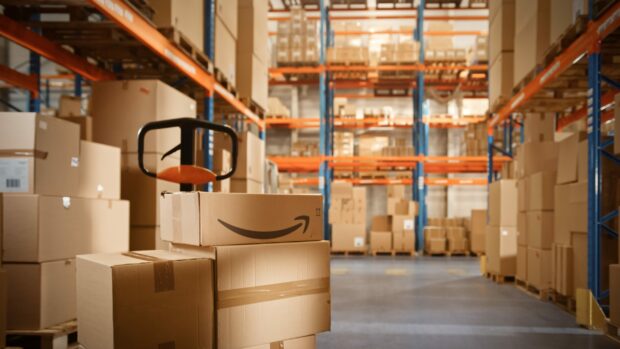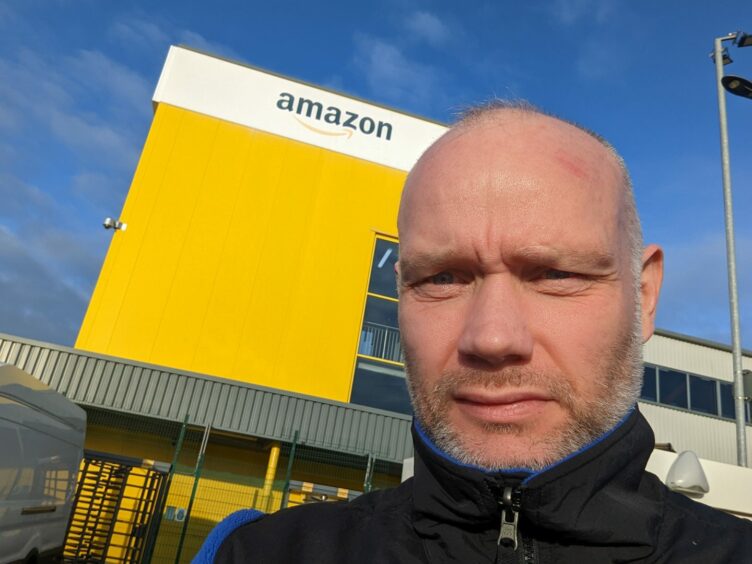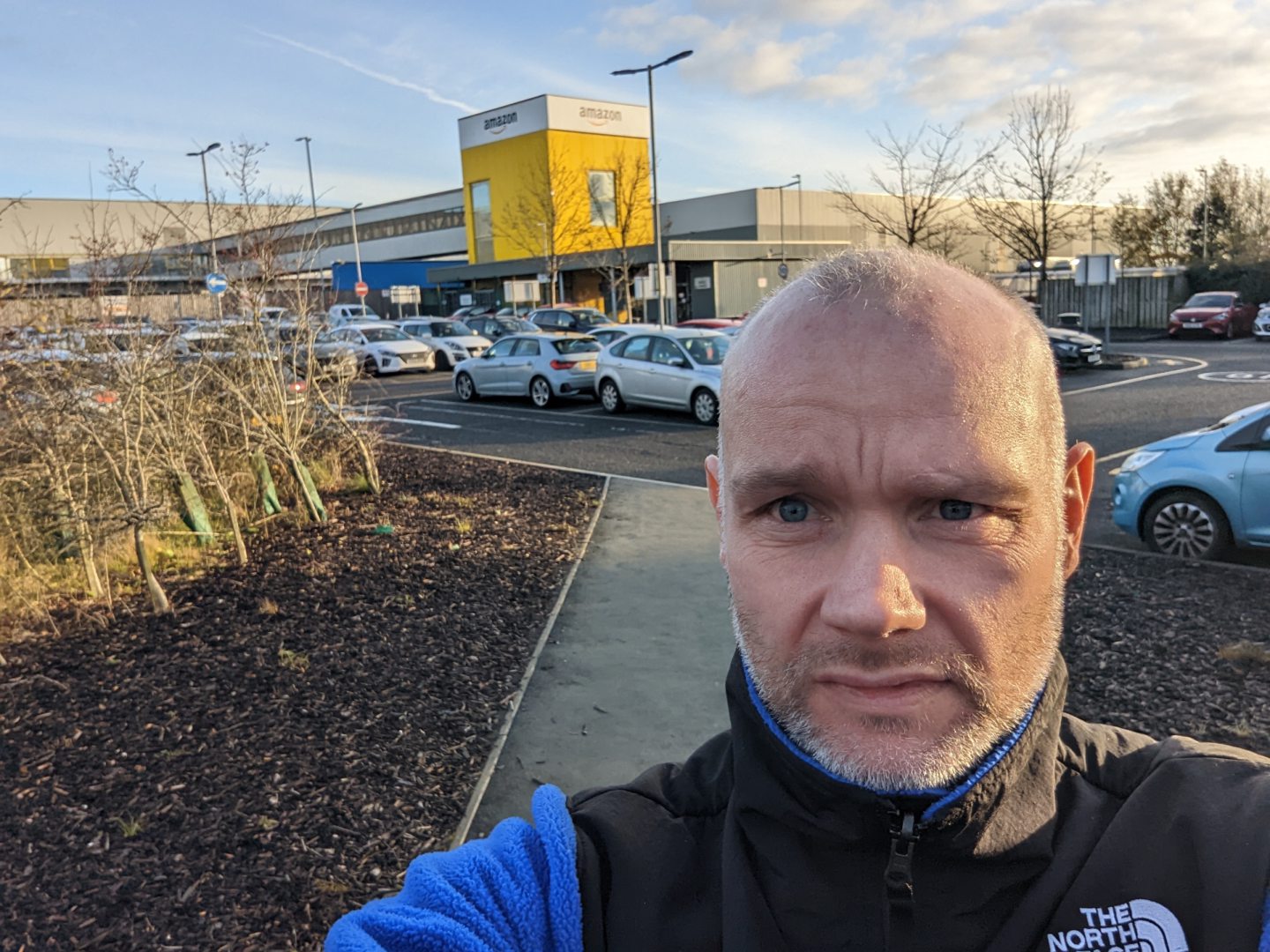
“Welcome to hell, mate.” I arrive for my first night at Amazon and must have the air of a new start as I am greeted by a passing colleague.
It is 7.25pm on a freezing Sunday night and I have followed him through the site’s buzzer-entry side door. I have already broken the rules apparently.
Just as I step through the doorway behind him, a disembodied voice demands: “Hey, hey, who are you?”
I tell the intercom speaker I am there to start a new job. “Right,” it says, “do not piggyback when going through doors here. Just get in.”
As we walk to the reception, my new workmate continues: “Nightmare place, mate, but I need the money. They will probably keep us until after Christmas and then bin us off. They used to get rid of folk just before Christmas but then they would go out in front of the building, burning their hi-vis vests. So now they wait until after Christmas.”
Amazon’s Dunfermline warehouse is the biggest in the UK – the size of 14 football pitches, or 93,000 square metres – and I have a sense of foreboding as we wait in an empty canteen for induction. I have been a journalist for many years and have also worked in retail, catering, construction, academia, sales and the military but I have never known a recruitment process as perfunctory and half-hearted.
Prompted by persistent concerns about how staff are treated by the online retail giant, as unions escalate their campaigns to represent workers and MPs investigate conditions, I intended to detail first-hand my experience working for Amazon. Applying to work there, I had no agenda and did not know what to expect or what I would find.
To be honest, I expected to be vetted out at an early stage of the recruitment process. However, there were no questions about skills, experience, previous employment or ambitions. A few online questionnaires, a 15-minute video call with HR who asked about my shoe size and whether I was a small, medium or large for a hi-vis vest, and then? I was in.
Waiting for the induction to begin, the building, brightly coloured and well-lit, still feels oppressive and daunting. We are taken into a side room just off the main reception area. There are 17 people in the room. We are, we learn, not workers but “associates”. Our workplace is not a warehouse but a Fulfilment Centre, or FC.
We are told to download the Amazon A to Z app that will log our shifts, overtime and pay. We are told we are allowed our phones on the floor – we are just not allowed to use them. If we receive a call from a number suggesting a domestic crisis, we must find a supervisor and ask if we can take the call. It is suggested, in passing, that citing a “family emergency” rather than illness if having to call in sick might help us keep our jobs.
What seems like an inordinate amount of time is spent instructing us on what we should do if an armed aggressor is on site: run, hide, tell, apparently. An equal amount of time seems to be given to assuring us this has never, ever happened.
In front of his new, soon-to-be-former colleagues, a young man is told he has failed his disclosure check. He has to discuss this with HR officials in front of everyone, apparently unaware that he might decently expect some privacy and confidentiality. Later, I find out one of the older new starts complained about the casual cruelty of it.
Soon, we are off to the shop floor to our work station. I am deployed to CR, Customer Returns, but, as we walk on to the main warehouse floor, a poker-faced man on a pallet truck trundles by. Over his shoulder, he says: “Get out of here while you still can.”
James Bloodworth remembers the same feeling of disconcerting unease when he started at Amazon. The author of Hired: Six Months Undercover In Low-Wage Britain, which was longlisted for the 2019 Orwell Prize, worked at the company’s warehouse in Rugeley, Staffordshire, for three weeks. He now boycotts Amazon and describes it as the worst employer he has ever experienced.
He says: “I was sick one day and I was given a disciplinary for that by management, even though I offered to get a note from the doctor. I was shocked by a lot of what I saw.”
Bloodworth worked 11-and-a-half hour shifts as a picker selecting goods for despatch. At the time, hoodies and sunglasses were banned at the site, along with mobile phones, as a security measure.
He says: “You walk between 10 and 15 miles each day. The bending down and lifting all day takes a physical toll on you: your back is in agony and your feet swell. The warehouse was huge. It was 700,000 square feet. Amazon used to boast it was the size of 10 football pitches. There were only two toilets we had access to. And to go to the bathroom we had to go through airport-style security.”
As I complete my 40 hours of night shifts for £490 before tax, Amazon owner Jeff Bezos, 58, earned £1.1 billion. Last month, he vowed to give away most of his £100bn fortune to charitable causes.
The fourth-richest person in the world said he wanted to support the fight against climate change, help unify humanity and overcome social and political divisions.
Country music legend Dolly Parton was recently awarded £85 million by Bezos to use for charitable causes.
But Bloodworth says the huge wealth of Bezos is not trickling down to his workers. He says: “We already have laws about sick days and minimum wage legislation. These things exist on paper but the reality on the ground can be quite different. It’s not just Amazon – we see that with other kinds of fast-fashion companies at the moment. That’s a big scandal with fast fashion because you have super-cheap goods but they’re super-cheap for a reason.
“There is a cost and it’s borne often by the workers themselves.”
In his book, Bloodworth also went undercover to investigate the high turnover rate of a telesales factory in Wales, the work of a council care worker, and the reality behind Uber.
He was shocked by the reaction from the online retailer. “Amazon actually tried to smear me and the book,” he says. “They didn’t take on any specific allegations in the book because it’s all true. It was more that they would attack my character and say, ‘oh, he just did it to sensationalise and he went in there with an intention to sensationalise what he saw’.
“That’s just not true. I went in completely open-minded and unsure what to expect. I had no idea but ended up shocked by the things I found out.”
In Dunfermline, we are quickly allocated a workstation, a table, a touch-screen monitor and a hand scanner, similar to the ones in supermarkets.
A conveyor belt runs along next to me. It carries what are called totes here – large, black plastic boxes filled with everything from showers to toys. I am lucky – our instructor is friendly, approachable and clearly knows the job inside out. Not everyone is so fortunate, as I come to find out later.
My job is to salvage returned goods for resale to customers unaware the items have been bought before.
During my week in returns, I barely moved from my standing workstation for every shift. The job is very physical – grabbing packed totes from the conveyor belt, scanning items, putting items in other totes and then sending them via the conveyor to the relevant section. By the end of each shift, my knees ache, my ankles and feet swell.
The computer tracks everything processed, any down time or “idle time” is logged, indeed everything touched is logged with the scanner. Supervisors have computers on trolleys that they wheel about checking on who is doing what and where everything is going. Some come over to analyse what I have been scanning and sending on. Others seem to be monitoring digitally what I’m doing and how quickly.
One of my colleagues says they have been here for three months but already have a disciplinary warning for performance figures in packing where workers are expected to deal with 350 to 500 items a shift.
“I was informally spoken to twice about it but then they said I had been given two verbal warnings. A manager came up to me when I had a bad cold and said, ‘your figures are rock bottom.’
“I said, ‘I know that but you can see I am ill. I come out to work, I am choked up and it’s probably one of the worst colds I’ve had in a long time.’ That impacted on my figures but it is Amazon’s way or no way.”
During breaks in the canteen, I chat with some of my new workmates. We seem to connect quickly. It feels similar to the swift camaraderie I found in the Army. Our ages range from early 20s to over 60 and we come from across the UK with a wide range of experiences.
Our breaks are high-intensity affairs. We get two half-hour breaks at 10.40pm and 2.10am (one paid, one unpaid) but negotiating the airport-style security bites into the time.
To go to and from the shop floor, you must weave through a series of metal detectors and scanners and a phalanx of security guards. Your phone and smartwatch will be marked with an Amazon sticker to show you haven’t stolen it off a shelf.
This sticker must be shown when going through security at the warehouse entrance. Belts must be removed. I’ve seen less security at several high-profile military installations and airports. At one briefing, we are told about the level of crime that apparently dogs the warehouse. A manager tells us theft was a big issue, saying security had been found to have been involved with the thieves at one point.
A worker tells me of an incident when a van was loaded up with stolen 50-inch TVs so perhaps there is justification for such stringent security measures but they can still feel oppressive.
As one shift follows another, I see things I find disconcerting. A young woman – who I hear has medical issues – is taken to task by a supervisor for going to the toilet too much. She said she was “embarrassed” after being told to watch her “idle time” after the algorithms flagged a concern.
Computers monitor everything, even when you go to the toilet, how many products you process, how much “idle time” you have taken.
Idle time is the bogey man of the night shift. Idle time means people not “on task” so workers aren’t dealing with goods. On another night, a man in his 60s is not allowed home from his shift to get his glasses. His home is only 20 minutes away but he ends up with a migraine trying to read the labels on the products he was scanning as well as trying to scrutinise the computer monitor.
I see another instructor confronting a man for being too slow on what is only his fourth day on the job. The worker started at the same time as me, English was not his first language and he had the same minimal training.
On one night, we have a hazardous material safety briefing that lasts a few minutes and features a quick questionnaire on a Kindle device.
We are told everything could end up here, from cyanide to arsenic. If we see a spill, we aren’t to touch it or attempt to clean it. We are issued with two safety gloves and told to wear one because we need a hand ungloved to deal with the touch-screen monitor.
I am thankful for the glove as, on my night shifts, I have to handle many questionable items, including a used bidet sprayer, a toilet step and a “sexy secretary” outfit (worn).
One of the instructors tells me: “It’s just about churning through people as the turnover is so high. It’s just about making money, that’s all.”
After only a few shifts, I start to feel sluggish. My diet has nose-dived. The facility has a canteen that sells cheap, fried food and an array of energy drinks. You can enjoy a full fry-up or pie, chips and beans at 2am. There is a fresh fruit cart but it is always empty.
Asking whether trade unions are allowed, I am hushed by one of the instructors, who say: “Don’t mention the unions, that’s like a swear word in here.”
Professor Muhammad Azizul Islam, an expert in sustainability accounting and transparency at Aberdeen University, tells me Amazon’s sheer size makes factors such as working conditions difficult for the firm to monitor. He says: “Amazon business operations are subject to pressures not only for workers’ rights in the global north but also for working conditions in their suppliers’ factories often located in the global south, including China.
“The problem with Amazon and other retailers is that they have not yet come up with any credible audit or transparency mechanism to track how their products are produced and how their services are given to the end user.
“As a retailer, a firm is not 100% sure that their products are produced in factories or sweatshops in the global south where human rights are maintained.
“They are not 100% sure that workers involved in delivering services even in the global north are free from any kind of exploitation.
“The lack of traceability of working conditions is a fundamental problem for Amazon and other similar organisations.”
Going undercover to investigate working life at one of Amazon’s biggest warehouses is an eye opener, revealing a number of safety, security and welfare issues.
Certainly, my experience jars with the evidence of Amazon’s head of public policy in Europe, Brian Palmer, when he recently appeared at a UK Parliamentary Select Committee as MPs investigate conditions.
He claimed the retail giant’s technology improved health and safety at Amazon sites and boosted job retention.
I was paid £10.50 per hour plus £1.75 for working nights. The basic rate is above the minimum wage but below the real living wage, a voluntary guideline adopted by 11,000 employers.
The mechanised, repeated motions of the job gives no satisfaction but delivers aching limbs and joint pain after a shift. My stint is in November, near Black Friday week, one of the firm’s busiest times of the year. It is also the worst month for ambulance call-outs to Amazon warehouses.
SNP MP Alan Brown is the only Scots MP on the Business, Energy and Industrial Strategy Committee that questioned the Amazon executives.
Brown said: “No wonder Amazon don’t like the idea of unions. The monitoring of individuals and using tracking to measure work-time is something Amazon denied when quizzed by the committee.
“It is vital Amazon opens itself up to scrutiny by an external body if it is to re-establish credibility in how they treat employees.”
Trade unions have been campaigning for months to gain a foothold in Amazon and Pat Rafferty, Unite Scottish Secretary, said my experience working there – including the computer tracking of work – highlighted persistent concerns. “It demonstrates what happens when workers are denied a collective voice and must be addressed,” he added.
“The Scottish Government should also be examining the concerns raised due to the public money Amazon has received and demanding a meeting with management in Dunfermline to demand unions get access to the workforce.”
The first strike at Amazon could take place at a depot in Coventry where members of the GMB union backed industrial action in support of a £15-an-hour pay claim. A union has also recently won recognition at a warehouse in New York and Martin Smith, national organiser for the GMB, said there is fresh hope: “Amazon has been attracted to essentially post-industrial areas, run-down areas, often with government money.
“It seems to assume it has landed in very, very loose labour markets so does not have to treat workers properly because there will always be more.
“But what it is finding is that the labour market has tightened massively and you cannot get away with alienating workers and communities.
“The Amazon management have made a public statement saying we have no objection to people joining unions but the idea that you’re free to join a union is nonsense.
“The issue of low wages feeds right into the issues that people bring to us, which is safety, health, the pace of the job and the lack of breaks.
“It produces average earning figures that shows on average people earning £30,000 but that includes software engineers in, for example, the Gourock site, who are on much higher wages.
“The other thing it does is to describe itself as an e-retailer and say wages in fulfilment centres are comparable to the retail sector.
“But the work is warehouse work and when you compare them to warehouse wages they are at least £3 an hour less than DPD or any other logistics companies.
“It’s all about low pay because people are trying to run faster, to curry favour, to get an overtime shift. It’s all interconnected.”
When I contacted Amazon, it accused me of sensationalism and said people should book a tour at the Dunfermline warehouse and see for themselves. It added: “We are proud of the safe, modern workplaces we offer across the UK. Employees also receive competitive pay, comprehensive benefits and great career development opportunities.
“We recognise that working in a warehouse isn’t for everyone but, for those who don’t want to sit at a desk all day, it’s a hugely rewarding job.
“Our teams work hard to ensure everyone is supported, treated with dignity and respect, that they take regular breaks and work at a comfortable pace. We know we’re not perfect and are constantly striving to improve but, the fact is, if you want to work in a warehouse, you’ll want to work at Amazon. “
The company said it does not monitor toilet breaks and “performance is only measured when an employee is at their station.” Staff have the choice to join a union, it added, but improvements to working conditions “are harder to do quickly and nimbly with unions in the middle.”
It said clearing security should take no longer than a minute and denied the claims that Dunfermline had suffered thefts involving security guards and claims of a van taking away televisions, adding: “We recognise that working in a warehouse isn’t for everyone but, for those who don’t want to sit at a desk all day, it’s a hugely rewarding job.”
In Fife, after a week of night shifts, I resign. I receive a perfunctory, templated email saying Amazon was sorry I was leaving and could I fill out a survey? I don’t think so and, as I walk slowly back to my car after being logged out for the last time, I breathe a sigh of relief into the frosty dawn.
Workers are essentially seen as machines and are competing with machines
Amazon’s warehouse workers are treated like machines, according to an expert on technology and work.
Dr Matthew Cole is a researcher with Fairwork, a project at the Oxford Internet Institute, University of Oxford, examining employment, productivity and technology.
He said 20th Century ideas such as Taylorism, the system of scientific management pioneered by engineer Fred W Taylor, remained influential. According to Taylor, factory management should analyse each job, determine which were essential, and eliminate unnecessary motions so that the worker, following a machine-like routine, became far more productive.
Cole said: “Conditions vary a lot depending on which part of the Amazon business you’re talking about.
“If you’re part of the management and that sort of career professional level, you’re remunerated very well and there’s a lot of career progression there.
“But if you’re part of the warehousing team, you’re treated as essentially a machine and you’re competing with the capacity of machines.
“You get stories of extreme digital Taylorism and more traditional Taylorism. By that, I mean highly regulated work tasks and meticulous time and motion regulation of how long it takes someone in the warehouse to pick an object, put it in a basket, move the basket and how long it takes to walk from A to B, how their scanners are tracked and so on.
“If you move from the warehouse to the delivery part of the organisation, it can then vary more as you have the way Amazon structures its delivery business.
“There are franchising agreements and people who own their own vans can set up delivery arms. They can also rent vans. They require an initial investment and so sort of subcontract it but it’s all Amazon branded.
“These are the heart of the delivery and logistics business in terms of last-mile logistics.”
Cole recently told the Digital, Culture, Media and Sport Committee at Westminster of the risk that data and surveillance technologies could saturate working life. Technology, such as voice or facial recognition, could be used in ways that do not benefit workers and also infringe upon privacy, he said.
“In academic literature there is a debate on whether or not we have a fourth industrial revolution or whether this is a paradigm shift,” added Cole.
“If you look at the growth of the major tech companies, whether it is Amazon, Microsoft, Apple, Alibaba, any of these huge players, they are supporting an entire ecosystem of Artificial Intelligence and data-based and cloud-based companies.
“They are shifting the infrastructures of society and therefore the infrastructure of work, whether in logistics or last-mile delivery or just in jobs like my own where now most of it is done through Microsoft Teams.
“The effects on work are very clear if you look around. One of the biggest issues concerns control over data.
“Data Protection Regulation provides a certain degree of protection for private individuals. However, it is more limited in protecting workers in the workplace.
“There are a few provisions that specifically deal with subject-access requests and protect workers against algorithmic decision-making, like hiring and firing purely by algorithm, but there is a lack of enforcement.
“Unless there is a union that is litigating around these things or an existing collective bargaining agreement, there is a lack of enforcement at the state level.
“The UK Government could do much better at ensuring protections for worker data and protecting citizens of the UK from global giants like Uber for example.”
Cole said Amazon’s way of recruiting a high-turnover workforce had a long history.
“It’s a very quick and easy process,” he said. “They basically hire anyone and
then push them according to their standards which are incredibly difficult physically for most people.”

Enjoy the convenience of having The Sunday Post delivered as a digital ePaper straight to your smartphone, tablet or computer.
Subscribe for only £5.49 a month and enjoy all the benefits of the printed paper as a digital replica.
Subscribe © SYSTEM
© SYSTEM © SYSTEM
© SYSTEM © Colorsport/Shutterstock
© Colorsport/Shutterstock © SYSTEM
© SYSTEM